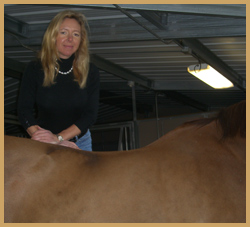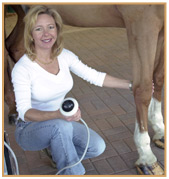
Jenny E. Johnson, V.M.D. Calabasas, CA (818) 809-SHWV (7498) (818) 878-9458 - fax equineshockwave.com |
||
| In This Issue | ||
• Main Story • Ask Dr. Johnson • Helpful Links • Chiropractic Q&A • Tell a Friend • Previous Issues • About Dr. Johnson |
||
| Ask Dr. Johnson | ||
Dr. Johnson is available to answer any questions you may have. Simply click here to email your questions directly to her. |
||
| Helpful Links | ||
International Veterinary Chiropractic Association Options for Animals Equine Shockwave |
||
| Tell a Friend | ||
Share a wealth of veterinary knowledge with your friends and colleagues. Click here to forward this email. |
||
| Previous Issues | ||
April 2008 - click here June 2008 - click here Sept 2008 - click here |
||
 |
| Veterinary Chiropractic Services |
March 2009 |
 Dr. Jenny Johnson is proud to announce the addition of veterinary chiropractic services to her practice. Dr. Johnson has completed 210 hours of postgraduate training in animal chiropractic at the Options for Animals program in Wellsville, Kansas. This training has included extensive lecture and practical hands-on training in the chiropractic care of horses and dogs. Dr. Johnson has successfully completed rigorous practical, clinical competency, and written exams and has earned certification in Veterinary Chiropractic by the International Veterinary Chiropractic Association. Dr. Jenny Johnson is proud to announce the addition of veterinary chiropractic services to her practice. Dr. Johnson has completed 210 hours of postgraduate training in animal chiropractic at the Options for Animals program in Wellsville, Kansas. This training has included extensive lecture and practical hands-on training in the chiropractic care of horses and dogs. Dr. Johnson has successfully completed rigorous practical, clinical competency, and written exams and has earned certification in Veterinary Chiropractic by the International Veterinary Chiropractic Association.What is Veterinary Chiropractic? Veterinary chiropractic is a holistic branch of veterinary medicine that focuses on the health and functioning of the nervous system. The nervous system controls all of the functions of the body including the motor and sensory functions as well as the functions of the organs of the body. The bony vertebral column has an intimate relationship with the nervous system in that it houses the spinal cord. If the joints of the vertebral column do not move as they should, this will affect the nerves that enter and leave the spinal cord. These nerves transfer information between the brain, spinal cord, organs, muscles, and other parts of the body. Muscle spasm or inflammation near a vertebral joint can cause a reduction in the normal range of motion of that joint. In chiropractic terminology, this is called a vertebral subluxation complex and it can affect the information that is being carried to the brain by the nerves that enter the spinal cord at this site. This, in turn, can lead to interference in the flow of stimuli or information between the brain and the body. It is important that these nerve fibers function normally in order for there to be smooth coordination of body functions and muscle contractions. Veterinary chiropractic focuses on the relationship between structure (primarily the spine) and function (as coordinated by the nervous system) and how that relationship affects the preservation and restoration of health in animals. The discipline of chiropractic emphasizes the inherent recuperative power of the body to heal itself without the use of drugs or surgery. Chiropractic care is not a replacement for traditional medical and surgical techniques but can be an important adjunct in the care of the animal as a whole. When is Chiropractic Care Useful in Animals? The purpose of chiropractic care is to optimize health. As such, all animals could benefit from regular chiropractic care. While chiropractic care is commonly associated with primary disorders of the back and neck, its usefulness is not limited to these areas. Any aberrant relationship between vertebrae of the spine may have an affect on the animal's movement or physiological activities. In addition, the nervous system is critical in maintaining a healthy immune system. In that the nervous system controls every function of the body, it is easy to see that a disruption to some portion of the nervous system could have an adverse affect in many areas. The spinal nerves exit the spinal column at each vertebral joint. These nerves innervate every structure in the body, including the internal organs. If there is a decreased range of motion at the vertebral joint where the nerve exits the spinal canal, it is likely that there may be accompanying inflammation and muscle spasm. This will affect the transmission of nerve signals between the body and the brain. This can lead to significant dysfunction either in the animalís motor function or in the function of the animalís internal organs. By adjusting this vertebral subluxation complex, the animal can function more normally. Chiropractic is frequently used as an adjunct in the treatment of many lamenesses and biomechanical abnormalities. There are many cases in which the traditional lameness exam does not fully identify the source of the lameness. Frequently, chiropractic care can provide useful information and treatment for these animals. Additionally, correction of chiropractic abnormalities may help other therapies such as intra-articular injections to be more effective and to have a more long lasting result. Similarly, there are many examples of medical conditions that do not fully respond to traditional care. Chiropractic should be considered as a treatment option in these cases. Chiropractic may be able to address a component of the problem that cannot be solved by medications alone. Additionally, chiropractic adjustment may enable the body to respond to the medications of traditional care more completely. What Are Some Symptoms that Indicate My Horse May Benefit from Veterinary Chiropractic Care? In addition to the above symptoms, veterinary chiropractic care may be useful in the following disease conditions by correcting biomechanical abnormalities of the spine or extremities: What can cause damage to the spine? How Often Will My Horse Need to be Adjusted? The protocol for each horse will be determined individually based on the findings of the veterinary chiropractic exam, the discipline of the horse and the horseís training regime. In most cases, a single treatment is not enough to eliminate the problem. The goal of veterinary chiropractic treatment is to address neurological dysfunction in the spine and restore mobility. It is then the task of muscles and ligaments to support the spine and maintain the restored motion of the spinal joints. Most horses will show significant improvement after one to four treatments. Chronic problems usually take longer to resolve requiring more chiropractic adjustments, while horses with acute problems often respond more quickly. Once the horse has achieved significant improvement, a supportive care schedule will be established if needed. Veterinary Chiropractic Care for the Dog In the dog, veterinary chiropractic care may be useful in treating: What can cause damage to the spine of the dog? Summary When done correctly, veterinary chiropractic care can be an effective way to help maintain the health of your animals. It can be used for chronic as well as acute problems. With chronic conditions, chiropractic treatment can support recovery and prevent secondary problems due to altered biomechanics of the skeleton. Increasing the quality of life or health is especially important when treating older animals, but chiropractic treatment of younger animals is also recommended as a preventive measure. Chiropractic treats the cause, not the symptoms of back problems. It restores joint mobility enabling the animal to maximize its performance potential. Training of the animal chiropractor Veterinary or animal chiropractic is a very specific science aimed at affecting the input to the animal's nervous system. As such, it is imperative that the individual performing the chiropractic adjustments have a thorough knowledge and understanding of anatomy and neurology in the animal affected, as well as education in the practical aspects of achieving an effective adjustment. It is very important that the veterinarian or chiropractor providing chiropractic care to animals is specifically trained in animal chiropractic. A veterinarian or chiropractor performing animal chiropractic should have completed at least 200 hours of intensive classroom work in a program accredited by the International Veterinary Chiropractic Association or the American Veterinary Chiropractic Association. A weekend course in animal chiropractic does not provide adequate training! In the hands of a well educated professional with this specific training, animal chiropractic care is a very safe treatment modality. |
|
| Chiropractic Q&A | |
Q: How can chiropractic care help my horse with navicular disease? A: Chiropractic care has the potential to help the horse with navicular disease by changing the biomechanics of the way the horse stands. For example, if a horse stands with his front legs too far underneath his body, this puts additional strain on the deep flexor tendon. The deep flexor tendon attaches to the back of the coffin bone and runs over the back of the navicular bone. If there is strain on the deep flexor tendon, this effectively jams the navicular bone into the back of the coffin bone and the 2nd phalanx with the result of there being additional pressure on the navicular bone. This can lead to degeneration of the navicular bone. By adjusting the horse, it is possible to correct the abnormal stance and thereby relieve the strain on the deep digital flexor and thereby the pressure on the navicular bone. |
|
| About Dr. Johnson | |
|
|
818-809-7498 | www.equineshockwave.com © 2009-2010 Oakhill Shockwave & Veterinary Chiropractic. All rights reserved. eNewsletter design by EquestriSol |
|
